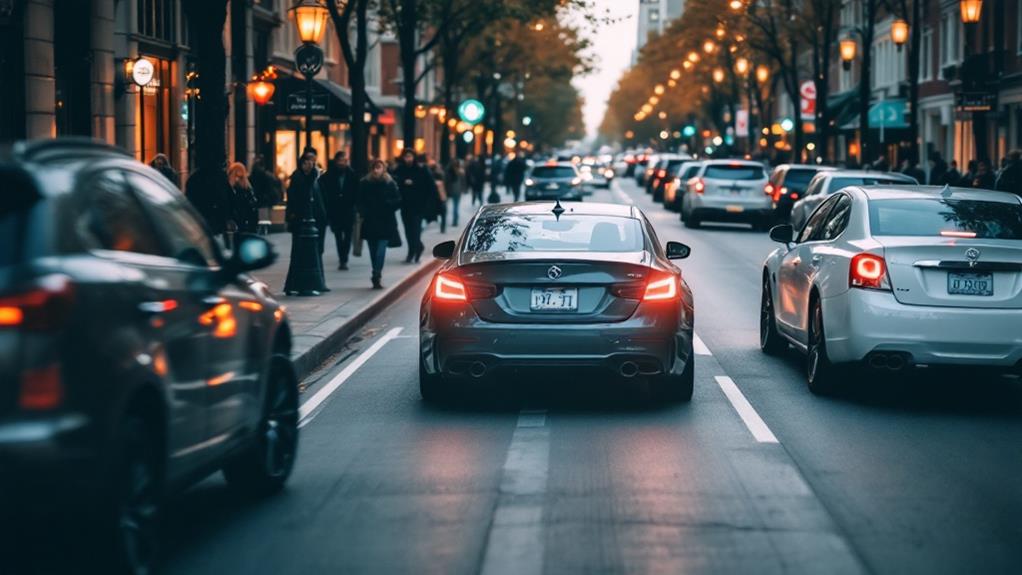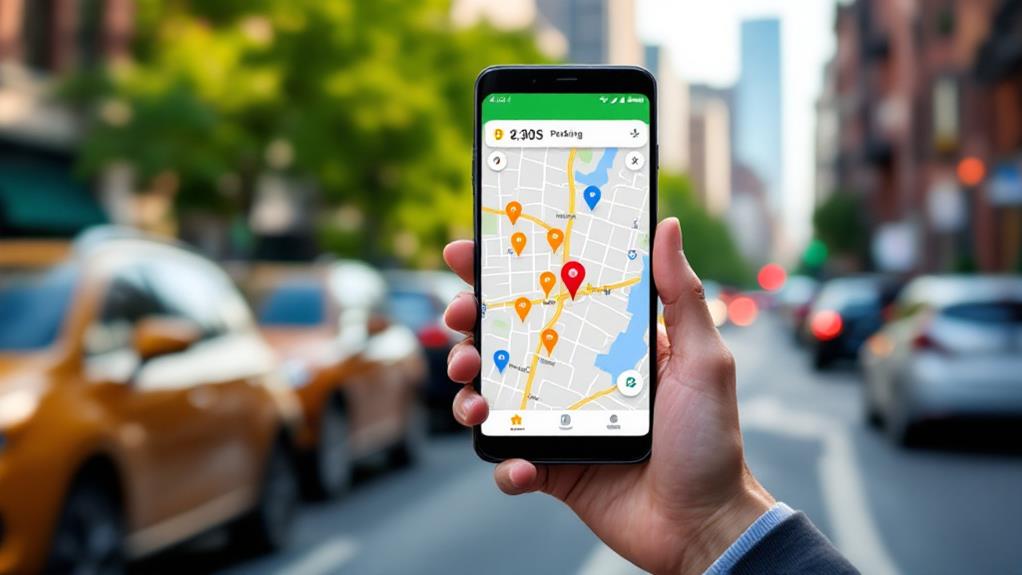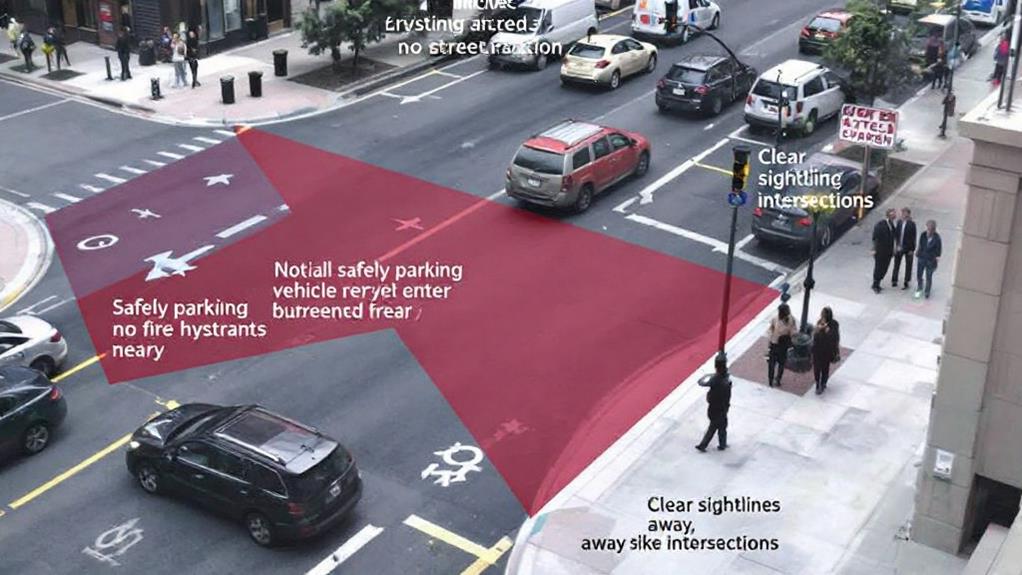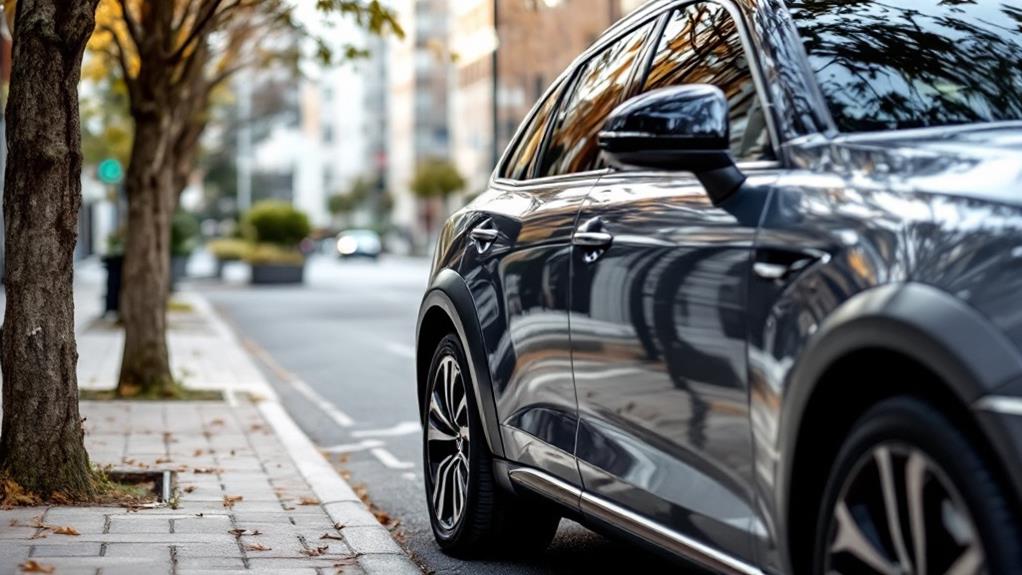Tips for Street Parking in Residential Neighborhoods
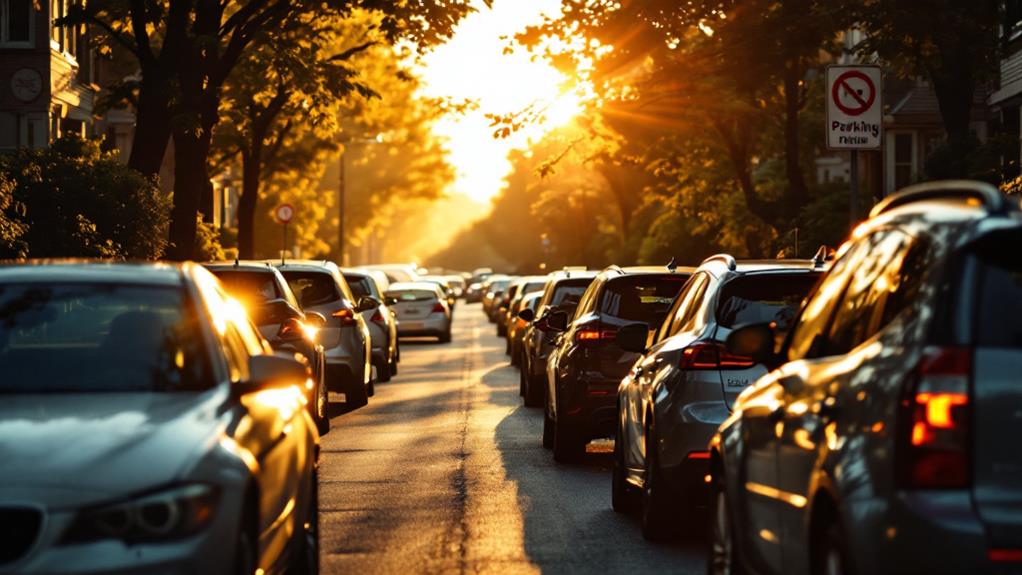
When street parking in residential neighborhoods, familiarize yourself with local regulations and respect time limits. Park parallel within 18 inches of the curb, avoiding driveways and intersections. Keep at least 20 feet away from crosswalks and fire hydrants. Use designated parking areas and be mindful of permit-only zones. Position your vehicle to maintain traffic flow and emergency vehicle access. Consider residents' needs by not blocking driveways or obstructing views. Pay attention to posted signs and use parking apps for alerts. By following these tips, you'll avoid fines and maintain good community relations. Uncover more strategies to become a courteous and law-abiding neighborhood parker.
Know Local Parking Regulations
When it comes to street parking in residential neighborhoods, knowing local regulations is indispensable. You'll need to familiarize yourself with specific parking ordinances, as they can vary considerably from one city or neighborhood to another. This knowledge will help you avoid costly tickets and guarantee you're being a considerate neighbor.
In many residential neighborhoods, you'll find that parking isn't allowed on the roadway side of a parked vehicle. This rule helps maintain clear traffic flow and prevents accidents. Additionally, you should be aware that parking within 20 feet of a crosswalk or driveway entrance is typically prohibited. These regulations aim to improve visibility and safety for both pedestrians and drivers.
Pay attention to the direction you park your vehicle and how close you are to the curb. Parking facing the wrong way or leaving more than 18 inches between your car and the curb could result in a ticket. In some areas, you may encounter permit parking programs that restrict on-street parking to residents with valid decals. Always check for signs indicating such restrictions before leaving your vehicle parked on the street.
Respect Driveways and Intersections
Respecting driveways and intersections is fundamental for maintaining good relationships with residents and guaranteeing smooth traffic flow. When parking your vehicle, be mindful of the space around driveways and intersections to avoid inconveniencing others or creating potential hazards.
Keep a safe distance from crosswalks and driveway entrances by not parking within 20 feet of these areas. This buffer zone allows for better visibility and easier access for pedestrians and drivers. Additionally, avoid parking directly across from driveways, as this can make it difficult for residents to enter or exit their properties. It's also pivotal for emergency vehicles to have clear access to homes.
When parking near intersections, pay attention to stop signs and make sure your parked vehicle doesn't obstruct drivers' views. This helps maintain traffic safety and prevents accidents. Remember to keep a proper distance from the curb, maintaining at least 18 inches between your vehicle and the curb edge. Failing to do so is considered illegal parking, regardless of how your car is oriented.
Lastly, always be aware of fire hydrants and never park within 15 feet of them. This space is essential for firefighters to access water quickly in emergencies.
Use Designated Parking Areas
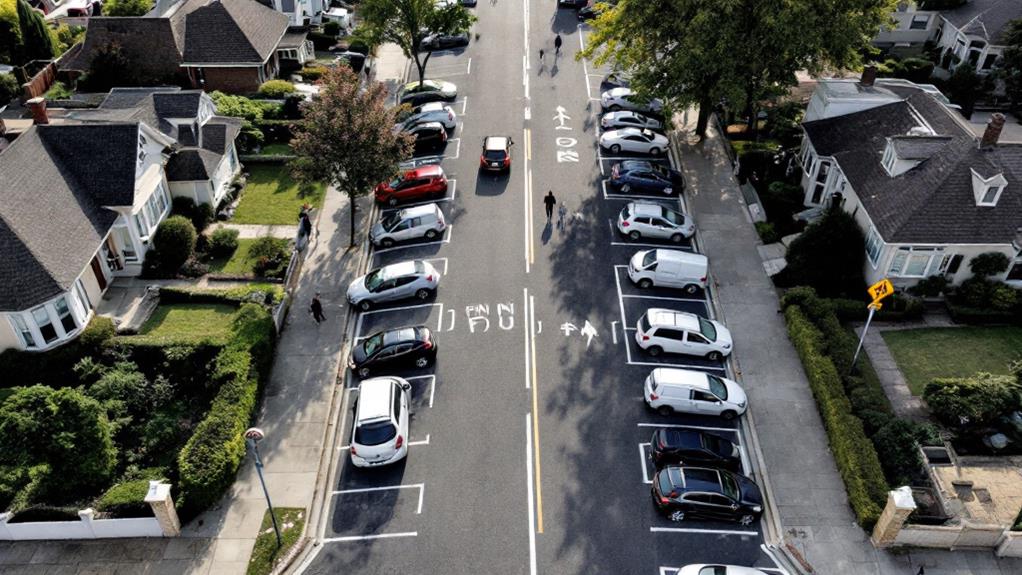
Designated parking areas are your best bet for hassle-free street parking in residential neighborhoods. Always look for clearly marked on-street parking spaces and use them when available. These spots are typically designed to accommodate vehicles without disrupting traffic flow or causing safety issues.
Before parking, familiarize yourself with any residential permit parking programs in the area. Some neighborhoods require special permits for long-term parking, so be aware of these regulations to avoid citations.
When you've found a suitable spot, guarantee your vehicle is stopped or parked parallel to the edge or curb. Position your wheels within 18 inches of the curb to comply with local parking regulations. This helps maintain proper street width for passing vehicles and emergency responders.
Pay close attention to posted signage indicating time limits and parking restrictions. Observe these rules to avoid fines and potential towing. Remember, even if you're in a designated area, don't park in spots that could impede traffic or block emergency access, such as in front of fire hydrants or too close to intersections.
Mind Time Limits
Time limits are an essential aspect of street parking in residential areas. When you park on the side of the street, it's vital to be aware of any time restrictions in place. Always check parking signs carefully to understand the specific time limits for that location. Exceeding these limits can result in a costly citation, so it's important to stay vigilant.
If you're parking at a metered spot or pay station, pay close attention to the posted time and guarantee you add more time before your session expires. To make this easier, consider using the ParkHouston app, which sends alerts when your parking time is running low. This allows you to add more time remotely, saving you from rushing back to your vehicle.
Be especially cautious during rush hour periods, as some areas have mobility lane restrictions. Parking in these zones during restricted times can lead to your vehicle being towed. To avoid any issues, familiarize yourself with the parking regulations outlined in the Texas Driver's Handbook. By staying informed and mindful of time limits, you'll have a smoother parking experience in residential neighborhoods.
Park Parallel and Close
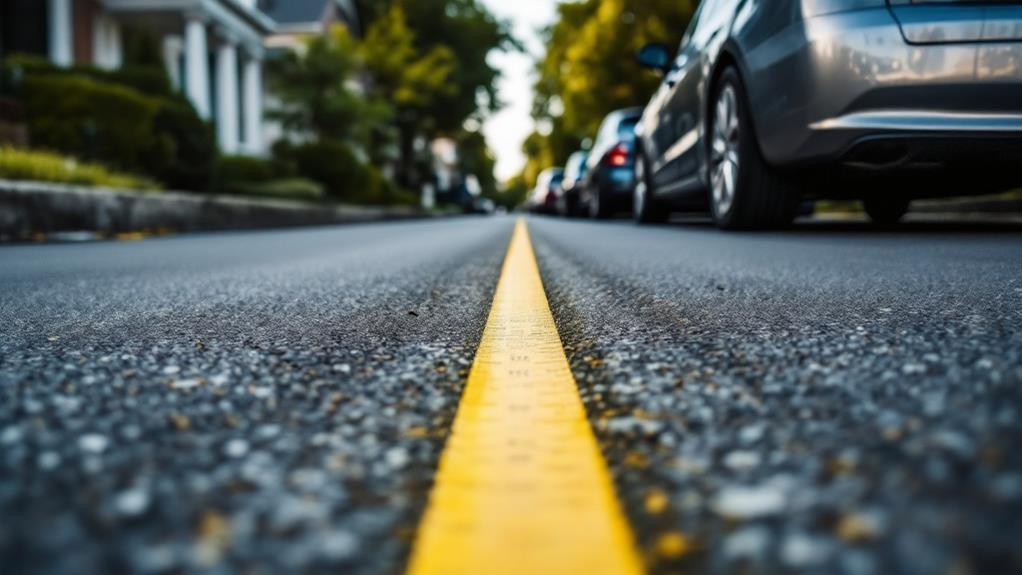
When it comes to street parking in residential areas, you need to keep your vehicle in line. It is crucial to park parallel to the curb and as close as possible, within 18 inches. This practice guarantees you're not obstructing the roadway and allows for smooth traffic flow, including access for emergency vehicles.
Your vehicle must be parked parallel to the curb on the roadway side. Avoid parking perpendicular or at an angle, as this can result in citations for illegal parking. Remember, proper parking isn't just about following rules; it's about being considerate to your neighbors and maintaining safety in the community.
Always park parallel to the curb
Position your vehicle within 18 inches of the curb
Avoid leaving excessive space between your car and the curb
Guarantee you're not obstructing traffic or emergency vehicle access
Be aware that improper parking can lead to fines or towing
Be Aware of Special Events
While proper parking techniques are important for everyday situations, special events can throw a wrench in your usual parking routine. When parking on the side of the street during special events, you'll need to be extra vigilant to avoid fines or towing.
Keep an eye out for red-bagged parking meters or temporary signs indicating special event restrictions. These may limit or prohibit parking on certain streets, so it's essential to park elsewhere if you spot them. Don't assume that your regular parking spot will be available during an event.
Be mindful of designated handicap or commercial loading zones, as they may have special rules during events. Always check both sides of a vehicle for any temporary "No Parking" signs that might be posted for upcoming events.
To guarantee you're parking legally and avoid citations, verify parking regulations with the City of Houston or ParkHouston before attending an event. This extra step can save you from the hassle of dealing with fines or retrieving a towed vehicle. By staying informed and observant, you'll be able to easily handle special event parking restrictions.
Consider Neighbors' Access
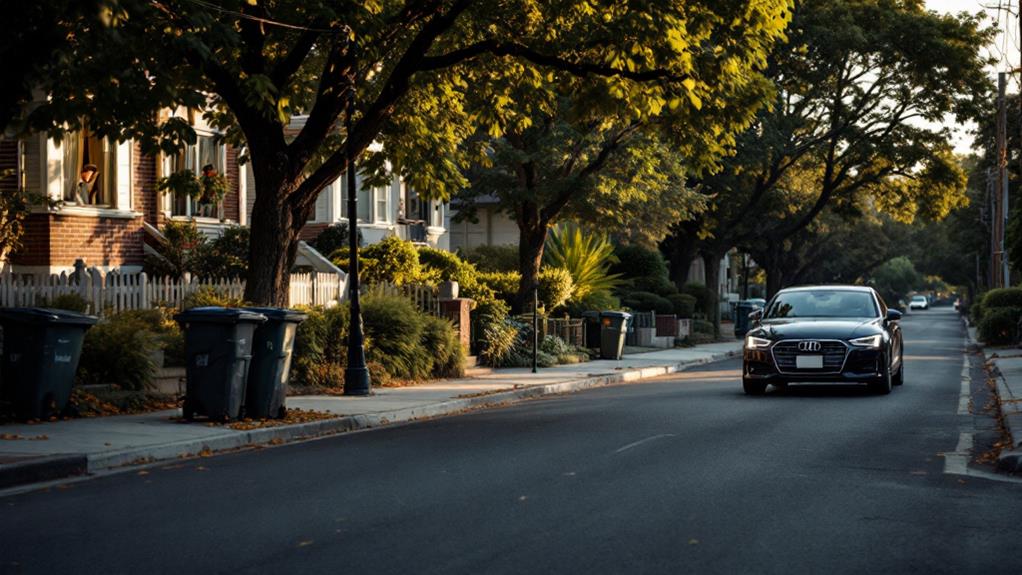
Thoughtful parking is essential for preserving positive relationships with your neighbors. When parking on residential streets, you'll need to be mindful of how your vehicle affects others' access and mobility. The Transportation Code often includes specific guidelines for street parking, but here are some general rules to follow:
- Don't park across from a neighbor's driveway
- Avoid blocking mailboxes
- Park at least 20 feet away from crosswalks
- Leave 18 inches between your car and the curb
- Ensure emergency vehicles can pass through
By following these guidelines, you'll help maintain a harmonious neighborhood and avoid potential conflicts. Remember that your parking choices can significantly impact your neighbors' daily lives. For instance, blocking a driveway can prevent someone from leaving for work or returning home. Similarly, obstructing mailboxes may result in delayed or undelivered mail for your neighbors.
It's pivotal to contemplate the needs of emergency vehicles when parking. Fire trucks, ambulances, and police cars require ample space to traverse streets quickly and safely. By parking thoughtfully, you're not just being a good neighbor – you're potentially saving lives by guaranteeing emergency responders can reach their destinations without unnecessary obstacles.
Watch for Emergency Vehicle Routes
Emergency vehicle access is a critical consideration when parking on residential streets. When you park your car, always keep in mind that fire trucks, ambulances, and police vehicles need enough space to traverse through the neighborhood quickly. To guarantee emergency vehicle routes remain clear, you should park your car as close to the edge of the street as possible, leaving ample room for larger vehicles to pass.
Remember to stay at least 15 feet away from fire hydrants when parking. This space allows firefighters to access the hydrants quickly in case of an emergency. Additionally, don't park within 20 feet of crosswalks or intersections, as this can obstruct the view of both pedestrians and emergency vehicles.
To maximize available space on the street, park your car parallel to the curb and within 18 inches of it. This helps create a clear path for emergency vehicles while also allowing other drivers to move through the street safely. By being mindful of these guidelines, you'll contribute to maintaining open emergency vehicle routes in your neighborhood, potentially saving lives in critical situations.
Utilize Private Driveways When Possible
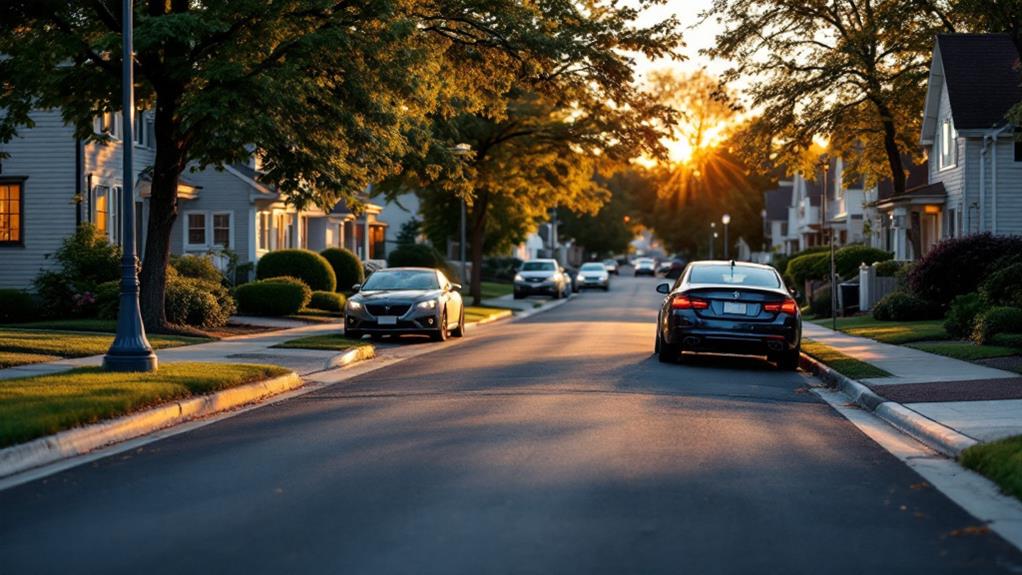
One of the most effective ways to alleviate street parking congestion is to employ private driveways whenever possible. By utilizing your own driveway, you'll contribute to a safer and more accessible neighborhood for everyone. Parking off residential streets helps maintain clear paths for emergency vehicles, school buses, and utility trucks, ensuring they can navigate the area without obstacles.
Prevents obstruction of traffic and pedestrian movement
Maintains access for essential vehicles
Contributes to a safer neighborhood environment
Helps avoid parking tickets or vehicle relocation fees
Supports smoother traffic flow on residential streets
When you choose to park in your private driveway, you're not only benefiting yourself but also your entire community. You'll reduce the risk of accidents, improve visibility for drivers and pedestrians, and create a more aesthetically pleasing streetscape. Additionally, you'll avoid potential fines or the inconvenience of having your car towed. By making this simple choice, you're playing a pivotal role in maintaining the safety and functionality of your residential area. Remember, your driveway isn't just a convenience—it's a critical asset for your neighborhood's well-being.
